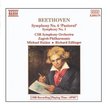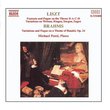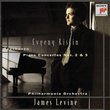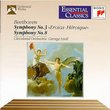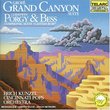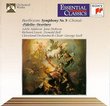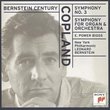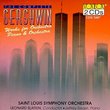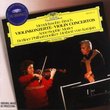| All Artists: Richard [1] Strauss, Zdenek Kosler, Slovak Philharmonic Chamber Orchestra, Slovak Philharmonic Orchestra, Slovakia Philharmonic Orchestra Title: R. Strauss: Also sprach Zarathustra; Salome's Dance; Rosenkavalier Waltzes Members Wishing: 0 Total Copies: 0 Label: Naxos Release Date: 6/30/1992 Genre: Classical Styles: Forms & Genres, Theatrical, Incidental & Program Music Number of Discs: 1 SwapaCD Credits: 1 UPC: 730099518222 |
Search - Richard [1] Strauss, Zdenek Kosler, Slovak Philharmonic Chamber Orchestra :: R. Strauss: Also sprach Zarathustra; Salome's Dance; Rosenkavalier Waltzes
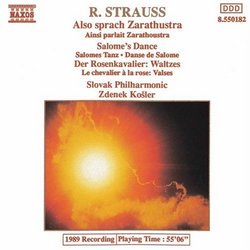 | Richard [1] Strauss, Zdenek Kosler, Slovak Philharmonic Chamber Orchestra R. Strauss: Also sprach Zarathustra; Salome's Dance; Rosenkavalier Waltzes Genre: Classical
|
Larger Image |
CD DetailsSimilar CDsSimilarly Requested CDs |
CD ReviewsDecent Performances slightly let down by the sound quality G.D. | Norway | 03/26/2009 (3 out of 5 stars) "This is actually not a bad recording of Strauss' masterpiece, although it does ultimately lack the detail and sumptuousness of, say, Karajan's Berlin Philharmonic recordings or the taut reins and urgent drama of, say, Reiner's approach. Indeed, the overall impression is one of something a little lackluster and just a little lacking in terms of dynamic range. But in the hands of Kosler and the Slovak Philharmonic, it does make a dramatic impact, and the joys and passions and the Hinterwelt are particularly finely shaped (if again a little rough and fuzzy). The two encore pieces hardly make much sense when played out of context, and here - in addition - the lack of polish is unfortunately all too noticeable. But then I guess people would generally want the disc for Zarathustra, if anything. Too bad, though, that they are slightly let down by the variable sound quality - which is unfortunately rather better in the two opera extracts than in the slightly distantly and artificially recorded Zarathustra. Do go for Karajan (or possibly Reiner) if you have the option, even though you wouldn't go seriously wrong with this one." Nihilistic Philosophy in Musical Garb Leslie Richford | Selsingen, Lower Saxony | 12/12/2004 (3 out of 5 stars) "Towards the end of the 19th century, the nihilist philosopher (and, in his youth, composer) Friedrich Nietzsche published a series of works in which he, the son of a Protestant clergyman, frontally attacked Judeo-Christian ethics, which he condemned as being totally opposed to the evolutionary principle of ?the survival of the fittest?. Nietzsche proposed replacing this religious ethic with an evolutionary ?Wille zur Macht? (will to power) which would involve deliberately destroying the weak (the old, the sick, the mentally debilitated and, presumably, Christians and Jews) and developing a ?Herrenrasse? (lordly race) consisting of ?Übermenschen? (super-men). It takes little imagination to see how this provided the German Nazis with a theoretical basis for their concentration camps, genocide, euthanasia, mass deportations and inhumane experiments on the mentally ill.
One of Nietzsche?s more poetic works was ?Also sprach Zarathustra? (Thus Spake Zoroaster), and it was this collection that inspired Richard Strauss, already an ardent adherent of the Liszt-Wagner school, to write, in 1895, a symphonic poem of the same name in which he attempted, to his own mind very successfully, to translate some of Nietzsche?s philosophical thought into musical language. Zoroaster, Nietzsche?s spokesman, rises with the sun to analyse the human condition and pour out his ?wisdom? on the earth. We hear of faith as man?s first attempt to understand the world, then replaced by ?joys and passions?, after which man turns fruitlessly to ?science? before being revived to laughter and dancing. (That is, of course, only an extremely compressed summary.) Philosophical programme music of this kind is not likely to be easy, and indeed, Strauss? musical poem is not only difficult but ambiguous until the end; one cannot even determine what key it is in. Perhaps typical of this ambiguity is the fact that it demands an enormous orchestra with fourfold woodwinds, six horns, four trumpets, three trombones, two tubas, an organ, two harps and a deep-sounding bell as well as a massive corpus of strings, but that on the other hand there are many passages which Strauss himself described as ?Streichquartettstellen? (passages for string quartet). This is music that one needs to listen to again and again; the popularity of the opening theme (used in the film ?2001 ? Space Odyssee?) should not lead one astray into not taking the whole work seriously. Strauss was, in a certain sense, a forerunner of the atonal movement at the beginning of the 20th century. The two ?encores? given on the CD can, against this background, be categorized as light relief. ?Salome?s Dance? from the opera ?Salome? is well-known for its oriental touches (and its totally unfounded erotic associations); the First Waltz Sequence from ?Der Rosenkavalier?, put together from Acts I and II of the opera by Strauss himself five years before his death in 1949, is, in my estimation, a sickly-sweet piece of reminiscence and nostalgia. Zdenék Ko?ler is a fine conductor and manages to inspire the Slovak Philharmonic to a respectable performance of all the pieces here, although it is obvious that the musicians are much more familiar with the two shorter pieces. The CD was recorded in two sessions in October 1988 and January 1989, and there is a considerable difference in the sound between ?Zarathustra? and the other two pieces. ?Zarathustra? is difficult to record because of the sheer size of the orchestra, and Naxos have not made a brilliant job of it, although the sound comes over fairly acceptably on the right equipment (powerful amplifier needed); the two opera extracts are considerably louder. " |

 Track Listings (12) - Disc #1
Track Listings (12) - Disc #1